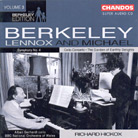February 2004
Berkeley’s son, Michael (b.1948) has just become composer in residence for the BBC National Orchestra of Wales, which has made a huge commitment to contemporary music since taking on Richard Hickox as its music director. The better of the two works recorded here, The Garden of Earthly Delight, was inspired by the famous Hieronymus Bosch painting in which the Renaissance artist portrays, in a triptych, the innocence of the Garden of Eden, its corruption from Carnal Knowledge, and the vengeance of Hell. Berkeley’s dramatic music is scored for a huge orchestra, which includes exotic percussion: claves, and a "lion’s roar," a sound produced by the friction of a cord within a resonant drum. There are also three soloists, which are placed at different points in the hall: violin, soprano saxophone, and trombone. Each soloist must also double on claves, rattles, and tam-tams. All of the compositions on the disc are performed with finesse and dedication. Hickox has a good sense of both dramatic and lyrical elements of the music; his readings seem ideal. The Welsh BBC orchestra proves itself world class all the way. The astonishing cello playing of Alban Gerhardt in the concerto is remarkable, even if I don't particularly care for the busy, uninspired, workmanlike nature of the piece itself. The SACD recorded sound is the best multichannel effort yet from Chandos. The basic soundstage is very wide and somewhat deep. Listen to the beginning of the third movement of the symphony. The woodwinds are centered at mid-stage, the lower strings are to our right and near the front of the stage, the brass choir is at the back of the stage and to the right, the harp is way to our left, near the front. One can practically draw a seating plan just from listening to the first five minutes. The balance between the soloist and orchestra in the concerto is ideal. The Garden of Earthly Delights offers additional spatial possibilities due to the placement of the three soloists. These are heard to the left and right in the surrounds and are very effective in creating a natural sound that envelops the listener, much as it would in the concert hall. The end of the work, with tam-tams crashing away from all over, is quite a thrilling experience. This SACD is part of a series in which there have already been two CD-only releases. Based on what I heard here, both from a performance and a music point of view, they would be well worth seeking out. GO BACK TO: |
 Lenox Berkeley: Symphony No. 4; Michael
Berkeley: The Garden of Earthly Delights, Cello Concerto
Lenox Berkeley: Symphony No. 4; Michael
Berkeley: The Garden of Earthly Delights, Cello Concerto  The music of Englishman Lenox Berkeley (1903-1989) is scarcely
known in this country, especially now that the Lyrita label is gone and EMI releases most
of its British music titles to the United States as imports. Lyrical, intelligent, often
urbane, his output deserves serious consideration. The piece presented here, his Fourth
Symphony, was commissioned by the Royal Philharmonic, and first performed in May of 1978.
It is a very compact composition consisting of three movements. The second is the best, a
set of five contrasting variations on a theme marked andante.
The music of Englishman Lenox Berkeley (1903-1989) is scarcely
known in this country, especially now that the Lyrita label is gone and EMI releases most
of its British music titles to the United States as imports. Lyrical, intelligent, often
urbane, his output deserves serious consideration. The piece presented here, his Fourth
Symphony, was commissioned by the Royal Philharmonic, and first performed in May of 1978.
It is a very compact composition consisting of three movements. The second is the best, a
set of five contrasting variations on a theme marked andante.